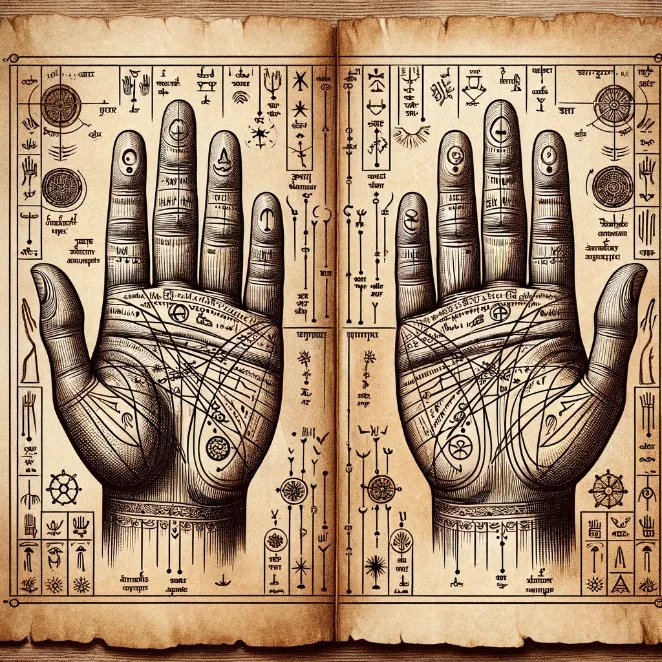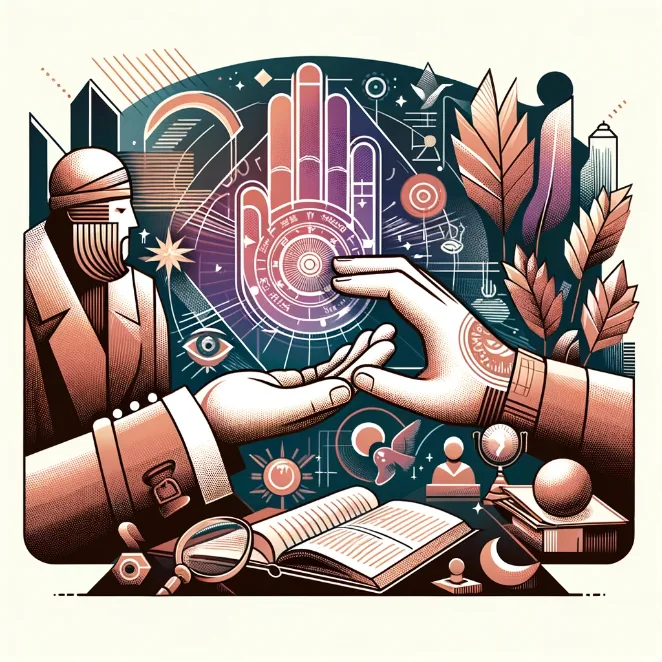
Palm Reading: An Odyssey Through Time and Techniques
Palmistry, a practice shrouded in mystique and rich with history, offers more than mere predictions; it's a journey through time and culture. This art of reading palms, deeply rooted in ancient civilizations, has traveled through ages, evolving and adapting, yet retaining its mystical allure. It stands at the crossroads of science, art, and spirituality, offering insights not just into one's future but also into their character and inner psyche.
article by Nora Pennington
The Ancient Roots of Palmistry
Palmistry, or chiromancy, is not just a modern fascination but a practice steeped in ancient history. Its origins trace back to various civilizations, including Indian, Chinese, and Egyptian cultures, each contributing unique perspectives to the art. In ancient India, palmistry was linked to astrology, forming a part of the Hindu Vedic scriptures. The Chinese saw it as a way to understand one's life path and personality. In ancient Greece, Aristotle's interest in the lines of the palm influenced its integration into Western mysticism. This rich historical tapestry of palmistry reveals its long-standing role in human curiosity about fate and self-understanding.
Palmistry in the Middle Ages: A Blend of Science and Mysticism
During the Middle Ages, palmistry flourished as a fusion of science and mysticism. It was a period where it intertwined with medicine and astrology, gaining popularity across Europe. Physicians and scholars often used palm reading as a diagnostic tool, believing that the lines and features of the hand could reveal clues about a person's health and temperament. This period saw the development of detailed palmistry manuscripts, which laid the foundation for modern interpretations of the lines and mounts. However, the practice also faced criticism and skepticism, particularly from the church, which viewed it as occult or heretical. Despite these challenges, palmistry's appeal persisted, intriguing minds fascinated by the mysteries of human nature.

The Renaissance of Palmistry: A Period of Reawakening
The Renaissance period marked a reawakening of interest in palmistry, driven by a renewed fascination with the human body and mind. This era saw a surge in the study of palmistry, with scholars and mystics delving deeper into its interpretations. The art was often discussed in the salons of the intellectual elite, where it was viewed as a sophisticated form of knowledge. During this time, palmistry began to shed some of its purely mystical associations, incorporating more empirical observations and rational approaches. Yet, it retained its mystical charm, captivating those who sought to understand the deeper aspects of the human psyche through the study of the palm.
The Techniques of Palm Reading
The core technique of palm reading involves analyzing the lines, shapes, mounts, and other features of the hand. Each element is thought to represent different aspects of the individual's life, character, and destiny. The major lines — the Life Line, Heart Line, and Head Line — are the focus of basic readings. Advanced techniques involve studying the smaller lines, such as the Fate Line and Sun Line, as well as the mounts, which are named after planets and correspond to different personality traits. Palmists also consider the hand's texture, finger shapes, and flexibility, offering a holistic view of the individual.

Modern Palmistry: A Tapestry of Tradition and Innovation
In modern times, palmistry has experienced a renaissance, blending traditional techniques with contemporary psychological insights. Famous practitioners like Cheiro (Count Louis Hamon) brought palmistry to the forefront of popular culture in the early 20th century. Cheiro, known for his celebrity clientele, famously said, "The hand is the visible part of the brain." His work emphasized the connection between the lines of the hand and one’s character and destiny. Another notable figure, William G. Benham, authored "The Laws of Scientific Hand Reading," a seminal work that approached palmistry with a scientific perspective. These practitioners played a pivotal role in elevating palmistry from mere fortune-telling to a more nuanced study of personality and potential.
Palmistry Today: Contemporary Perspectives and Practices
Today, palmistry is viewed through a more holistic lens, often used as a tool for self-discovery and psychological insight. Contemporary palmists like Johnny Fincham have continued to evolve the practice. Fincham’s approach integrates traditional palmistry with modern psychology, emphasizing the hand's dynamic nature. His viewpoint, "The hand is a powerful tool for self-discovery, and offers a way to achieve greater self-awareness and unlock our potential," reflects the current trend in palmistry, which focuses more on personal growth and understanding. This modern interpretation of palmistry resonates with a broad audience, appealing to those seeking both self-knowledge and a connection to an ancient tradition.
The Art of Reading: Learning and Practice
For those interested in learning palmistry, the journey involves patience, observation, and practice. Beginners are advised to start with understanding the major lines and gradually delve into the more complex aspects. Many palmists emphasize the importance of intuition in interpreting the lines and features of the hand. Continuous learning and practice, along with a respectful approach to the art, are key to becoming proficient in palmistry.

Palmistry's allure lies in its blend of history, mystery, and the quest for self-knowledge. It serves as a bridge between the mystical and the personal, offering a unique way to reflect on one’s life journey. Whether approached with a belief in its esoteric aspects or as a tool for introspection, palmistry continues to fascinate and engage people across the world.
Published: 11/13/2023
Modified: 11/13/2023
More predictions
Come back here soon to learn more about yourself and your future





